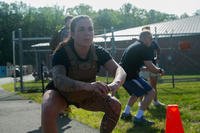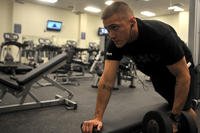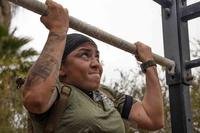Many people ask about how tough it is to become a Navy SEAL. The following article details the requirements starting with the physical fitness test for the Navy SEALs training program, known as BUD/S (Basic Underwater Demolition/SEALs).
Are you up to it?
Navy SEAL PST Standards
| PST Event | Minimum Standards | Competitive Standards |
|---|---|---|
| 500-yard swim | 12:30 | 8 minutes |
| Push-ups | 50 | 80-100 |
| Sit-ups | 50 | 80-100 |
| Pull-ups | 10 | 15-20 |
| 1.5-mile timed run | 10:30 | 9-10 minutes |
To qualify for a contract, a prospective candidate must meet the minimum requirements. It is recommended that you strive for the optimum fitness standards and beyond to improve your chances at BUD/S. Check out the official Navy SEAL PST calculator to compare your scores and rank you with other prospective candidates.
For more information on academic, medical screening and background requirements, see the official Navy SEAL/SWCC page at www.sealswcc.com.
Navy SEAL Fitness Test Breakdown
Swim 500 Yards
Maximum time allowed is 12 minutes, 30 seconds -- but to be competitive, you should swim the distance in at least 8-9 minutes, utilizing only the combat swimmer stroke, sidestroke or breaststroke.
Recommended workout and training tips: Get technique training and learn to pace yourself. Try 5-10 sets of 100-yard swims, working on a pace that will get you below the competitive times. (Rest 10 minutes after swimming the 500-yard test before moving on to the next exercise.)
CSS Stroke Demonstration
Push-ups
The minimum number is 42 in two minutes, but you should shoot for at least 100 for an average score. Do not pace yourself. Push as many push-ups out as fast as you can, but do not neglect proper form or the SEAL instructor will not count them. (Rest two minutes, then move on to the next exercise.)
Sit-ups
The minimum number is 52 in two minutes, but you should strive for at least 100 for an average score. Pace yourself. Try doing 20-30 sit-ups in 30 seconds; that will put you within the range of 80-100 sit-ups for two minutes. (Rest two minutes.)
Pull-ups
The minimum is eight pull-ups with no time limit, but you cannot touch the ground or let go of the bar. You should be able to do 15 to 20 to be competitive. Try a pyramid of pull-ups: Work your way up from one pull-up the first set until you no longer can do any more sets, then return down the pyramid repeating in reverse order (1, 2, 3, 4, 5, 6, 5, 4, 3, 2, 1). (Rest 10 minutes before the last exercise of the test.)
1.5-mile run
Wearing boots and pants, the maximum time allowed is 11:30, but you should cover the distance in 9-10 minutes to be competitive. Do not start off too fast on the first lap. Shoot for 90 seconds for a quarter-mile run around a standard high school track. Repeat this pace for 6-10 sets until you no longer have to rest between quarter-miles.
Talking BUDS Prep with Joe Kauffman (BUDS Instructor)
One of the best workouts to assist increasing your scores in the PT and run is the following:
-- 100 pull-ups in as few sets as possible. Run a quarter-mile in 90 seconds between sets of pull-ups.
-- 200 push-ups in as few sets as possible. Run a quarter-mile in 90 seconds between sets of push-ups.
-- 300 sit-ups in as few sets as possible. Run a quarter-mile in 90 seconds between sets of sit-ups.
This is a tough workout that can take 30-60 minutes to complete -- if you can complete it.
There is very little difference in the type of person who joins the Army Green Berets, Marine RECON, Air Force pararescue jumpers or Navy SEALs. There is one main thing that all Special Forces units have in common: Minimum standards are ignored, and they always push themselves to their maximum physical effort.
If you shoot for these minimums, you are destined to go to BUD/S and just try to survive each event of the day. That mentality will wear on you quickly, and you likely will quit or become injured from lack of training or overuse injuries.
Once again, you should go to BUD/S with high standards for yourself and compete for the best scores of the class in several events. Do not go to BUD/S just wanting to survive the training. You have to be more aggressive than that and not let the mind games and verbal harassment of the instructors affect you negatively.
You only can succeed by channeling any negative feedback and turning it into a positive, self-fueling energy. You should think that nothing anyone will say will make you doubt your abilities. If you can do the above recommended standards, you are more than halfway to graduating. The next half of success is the internal drive and determination, coupled with the understanding that you know you will be driven to discomfort most of the time.
For the latest in academic, physical, psychological and background requirements, see the official Navy SEAL/SWCC page at www.sealswcc.com.
The BUD/S PFT is a tough workout. If you know you are not up to it, do not try it. If you have doubts, consult your physician.
How to Get to BUDS
Related Navy Special Operations articles:
Navy SEAL Fitness Preparation
How to Prepare for BUD/S
Top Things to Know Before BUD/S
Getting Fit for SEAL Training
The Complete Guide to Navy SEAL Fitness
Joining Naval Special Operations
Navy SWCC Fitness Training
All Navy Special Operations Fitness
PT programs to train for the Navy PRT can be found at these Military.com links:
Pull-ups/flexed arm hang
Push-ups and sit-ups
Running
Swimming
Stew Smith is a former Navy SEAL and fitness author certified as a Strength and Conditioning Specialist (CSCS) with the National Strength and Conditioning Association. Visit his Fitness eBook store if you’re looking to start a workout program to create a healthy lifestyle. Send your fitness questions to stew@stewsmith.com.
Want to Learn More About Military Life?
Whether you're thinking of joining the military, looking for fitness and basic training tips, or keeping up with military life and benefits, Military.com has you covered. Subscribe to Military.com to have military news, updates and resources delivered directly to your inbox.



















